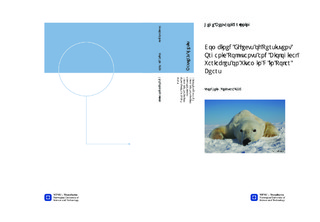| dc.description.abstract | Because of long-range transport, the Arctic is chronically exposed to persistent organic pollutants (POPs), such as polychlorinated biphenyls (PCBs), pesticides and brominated flame retardants, such as polybrominated flame retardants (PBDEs). Because of POPs are persistent and lipofilic, they are bioaccumulated in lipids and biomagnified in the food chains. The structures of some POPs resemble endogenous hormones, and have been shown to disrupt the TH homeostasis in animals. It has also been reported that POPs may affect the levels of vitamin D in seals, and thereby possibly disturb the calcium homeostasis and bone metabolism. The polar bear (Ursus maritimus) is a top predator in the Arctic and is exposed to high levels of POPs through its diet. However, the polar bear has a very good capacity to biotransform (metabolize) POPs, and because of the restrictions in the use of industrial chemicals and pesticides, the levels of POPs in polar bears from Svalbard have decreased during the last ten years. Still, polar bears have the potential to accumulate high levels of the most persistent congeners of PCBs. The aim of this study was to investigate the combined interactive influences of POPs and thyroid hormones (THs: free T4 [FT4], total T4 [TT4], free T3 [FT3], total T3 [TT3]) on 1,25-dihydroxyvitamin D3 (1,25(OH)2D) in two groups of female polar bears in different physiologic status, (females with cubs of the year [FWCOY] and females without cubs of the year [FWOCOY]) and in males. Blood samples from eight FWCOY, 15 FWOCOY and 20 males were obtained from the population at Svalbard, Norway, in April and May of 2008. Plasma concentrations of 1,25(OH)2D and THs were analysed by radioimmunoassay. Plasma concentrations of POPs were analysed using gas chromatography-mass spectrophotometry (GC-MS). Levels of 1,25(OH)2D, was examined in relation to contaminant load, biological and environmental factors by the use of principle component analysis (PCA), orthogonal projections to latent structures (OPLS) analysis, analysis of variance (ANOVA) and Pearson´s and Spearman´s rank correlation tests. Levels of 1,25(OH)2D did not differ significantly between the three groups of adult polar bears. In FWCOY, both multivariate data analysis and bivariate correlation tests indicated positive relationships between plasma levels of 1,25(OH)2D and plasma levels of THs (FT3, FT3:TT3, FT4 and TT4), age and biometric variables (zygomatic width). Negative relationships were indicated between levels of 1,25(OH)2D and two POPs (HCB and BDE-153). For FWOCOY, there were indicated positive relationships between 1,25(OH)2D and mainly OH-PCBs, but also PCBs, PBDEs and pesticides seemed to be positively related to 1,25(OH)2D levels. In contrast, one PBDE was negatively related to 1,25(OH)2D, but this compund was suspected to have high background levels. Thus, this particular relationship should be considered weak/semi-quantitative. None of the THs or the biometric variables were related to 1,25(OH)2D levels in FWOCOY. However, it should be noted that in FWOCOY, the OPLS model was relatively weak, with fairly low explained variance. In males, both multivariate data analysis and bivariate correlation tests indicated positive relationships between 1,25(OH)2D levels and THs (TT3 and TT4). Although in males the multivariate data analysis indicated that several of the contaminant compounds and some of the biometric variables were related to 1,25(OH)2D levels, the bivariate correlation tests did not support that. It should also be noted that the OPLS model for males was weak, with low explained variance and low predictability. Thus, for males, no final conclusion can be drawn based on the model. The results suggests possible vitamin D endocrine disrupting effects of mainly OH-PCBs on the most active metabolite of vitamin D3, 1,25(OH)2D. The results also indicate that there may be combined (interactive) effects of POPs and THs on plasma levels of 1,25(OH)2D in polar bears. Because of the dominance of OH-PCBs in the plasma of both female and male polar bears, and their known thyroid hormone disrupting effects, the potential disrupting effects of OH-PCBs on the vitamin D endocrine system indicated in this thesis, suggest the need for further research. | nb_NO |

